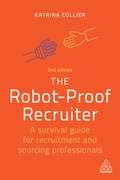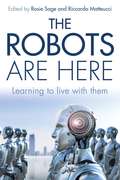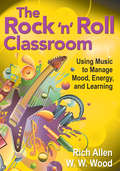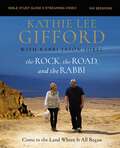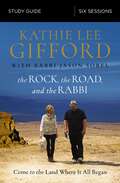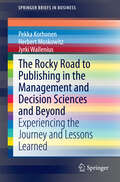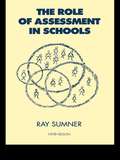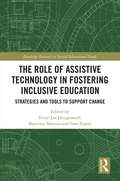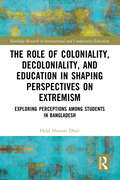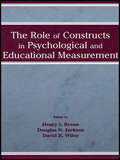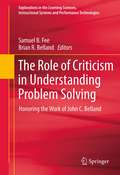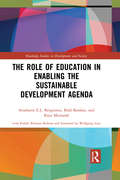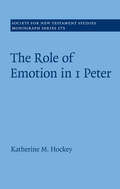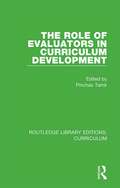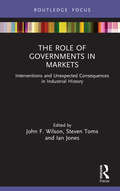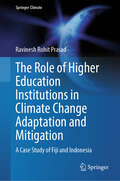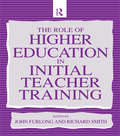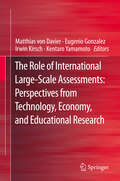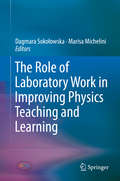- Table View
- List View
The Robot-Proof Recruiter: A Survival Guide for Recruitment and Sourcing Professionals
by Katrina CollierThe noise and transparency created by the internet makes it harder to recruit the right people. This second edition will help you become the recruiter that candidates trust and want to talk to. The Robot-Proof Recruiter shows you how to use a human-first approach to hiring that will help you grab and hold a candidate's attention better than a robot! It contains essential guidance on overcoming obstacles, including how to recruit without an existing online presence, how to work effectively with hiring managers to improve the outreach and candidate experience, and how to use technology to support the candidate's journey from initial outreach, through to application, successful onboarding, and later to alumnus. The second edition covers the unexpected impact of the COVID-19 pandemic on recruiting, and how using unique human qualities in conjunction with technology can enhance employer branding and candidate experience. Full of expert guidance, practical tips and updated case studies, this book explains what works, what doesn't and how you can stand out and recruit effectively. The Robot-Proof Recruiter is an indispensable book for all recruitment professionals and HR practitioners who want to recruit the right people for their organization.
The Robots are Here
by Rosemary Sage Riccarda MatteucciTechnology is redefining what it means to live in society and be human.This book assembles research and practice on educational robotics (intelligent machines) with a particular focus on the practices in Britain and Italy, the latter of which is a leading nation in preparing students for the New Industrial Age.Now that intelligent machines are capable of undertaking all routing tasks, robotics can provide three-dimensional development - personal, practical and academic - for the improved communication and thinking that students need for higher-level work. Students no longer need drilling in facts, now accessed by the touch of a button, but require greater attention to personal and practical abilities to meet global challenges.Readers are made aware of new learning approaches to achieve the flexible, broader abilities that aid survival and well-being.
The Rock ′n′ Roll Classroom: Using Music to Manage Mood, Energy, and Learning
by Rich Allen W. W. WoodPump up the volume to increase student learning!Picture this: a room full of boisterous students suddenly calms. A sluggish afternoon math or language arts lesson turns dynamic. Music pours from an inexpensive MP3 player, and you maintain control of your classroom without a word. Drawing on both educational and neuroscientific research, Rich Allen and W.W. Wood unlock the mystery of managing mood, energy, and learning with music in this fascinating, one-of-a-kind handbook. No matter what subject or grade you teach, The Rock ′n′ Roll Classroom provides all the notes you′ll need to shake up your classroom, including:Playlists customized for specific purposes like reducing stress or increasing focusTips and tricks for accessing all your tunes easily and inexpensivelyAnecdotes from teachers about how they use music to manage everyday situationsSample lessons for across all grade levelsGet ready to tune in to this brain-compatible learning method, engage each and every one of your students, improve the power of your instruction, boost test scores and creativity, and turn on the power of music in your classroom!"This is the book I have been waiting for! I have tried to use music in my classroom for years and have always felt like I fell short, but didn′t know how to fix it. Now I have a better understanding of how to use music in my classroom in a fun and effective way."—Pamela L. Opel, Science Curriculum SpecialistGulfport School District, Biloxi, MS"Teachers will rock their students′ day with The Rock ′n′ Roll Classroom. This comprehensive work not only applies to enhancing classroom instruction, but has a world of information on the topic of music as it affects us every day."—Beth Madison, PrincipalRobert Gray Middle School, Portland, OR
The Rock, the Road, and the Rabbi Bible Study Guide plus Streaming Video, Updated Edition: Come to the Land Where It All Began
by Kathie Lee GiffordThis Bible Study Guide includes an access code to stream all six video teaching sessions.Begin your journey to a deeper faith by traveling to the land where the Bible was written.Kathie Lee Gifford and Rabbi Jason Sobel will take you and your group beyond the typical "Sunday school" teaching to examine the true texts of the Bible.In this six-session video Bible study (video streaming code included), Kathie Lee invites you to join her as she visits sites in Israel that have impacted her faith and understanding of Scripture. As she shares her story, coauthor Rabbi Jason—a messianic Jewish rabbi—provides fascinating background details that make the story of the New Testament come alive.As Kathie Lee and Rabbi Jason reveal in this study, Jesus (the Rock) came into this world and walked the lands of Israel (the Road) to show us the way to God. And when we are introduced to the mysteries of God&’s Word (the Rabbi) and understand it in the context in which it was written, radical transformation begins to renew our hearts and minds.Sessions and video run times:Bethlehem: Where It All Began (13:30)Nazareth: The Early Years (13:30)Capernaum: Ministry Headquarters (14:00)Galilee: Ministry Grounds (16:30)Mount of Olives: The Triumphal Entry (13:30)Jerusalem: Crucifixion and Resurrection (14:30) This study guide has everything you need for a full Bible study experience, including:The study guide itself—with discussion and reflection questions, video notes, and a leader's guide.An individual access code to stream all video sessions online. (You don&’t need to buy a DVD!)Streaming video access code included. Access code subject to expiration after 12/31/2028. Code may be redeemed only by the recipient of this package. Code may not be transferred or sold separately from this package. Internet connection required. Void where prohibited, taxed, or restricted by law. Additional offer details inside.
The Rock, the Road, and the Rabbi Bible Study Guide: Come to the Land Where It All Began
by Kathie Lee GiffordKathie Lee Gifford always believed the Bible held the answers to every question a person could ask. Her problem was: how could she be sure of what the Bible was really saying when we are so separated from the ancient Jewish culture in which it was written? As a lifelong student of Scripture, Kathie Lee Gifford has always desired a deeper understanding of God&’s Word and a deeper knowledge of God Himself. But it wasn&’t until she began studying the biblical texts in their original Hebrew and Greek—along with actually hiking the ancient paths of Israel—that she found the fulfillment of those desires. In this six-session video study (DVD/video streaming sold separately), Kathie Lee invites you to join her as she visits sites in Israel that have impacted her life. As she shares her story, Rabbi Jason Sobel, a messianic Jewish rabbi who was trained in the ancient rabbinical way, provides fascinating background details into the language, culture and heritage that make the story of the New Testament come alive. Kathie Lee and Rabbi Sobel will take you and your group beyond the typical "Sunday school" teaching to examine the original texts of the Bible. Now you can walk with Kathie on a journey through the spiritual foundations of her faith: The Rock (Jesus Christ): Hear directly from Kathie about her life-changing and ever-deepening connection with Jesus, the Lover of her soul. The Road (Israel): Explore dozens of ancient landmarks and historical sites from Israel, the promised land of God&’s covenant. The Rabbi (God&’s Word): Go beyond a Sunday-school approach to the Bible by digging into the original languages and deeper meanings of the Holy Scriptures. Come! Explore the land of Israel and mine the treasures of God's Word. There is so much more! Sessions include: Bethlehem: Where It All Began Nazareth: The Early Years Capernaum: Ministry Headquarters Galilee: Ministry Grounds Mount of Olives: The Triumphal Entry Jerusalem: Crucifixion and Resurrection Designed for use with The Rock, the Road, and the Rabbi Video Study (9780310095033), sold separately.
The Rocky Road to Publishing in the Management and Decision Sciences and Beyond
by Jyrki Wallenius Pekka Korhonen Herbert MoskowitzThis book documents the history of two research papers, from the first drafts to the final polished published articles, including the reviewer comments and the author responses. The documentary provides unique insights into the publishing process, which at times is filled with uncertainties, not only for young researchers. The book discusses lessons learned and also provides an experienced editor's and reviewer's perspective. In the light of the high pressure on young faculty to publish successfully, this book offers itself as a guide to publishing efficiently and effectively in a highly competitive scientific environment.
The Role of 'Experts' in International and European Decision-Making Processes
by Monika Ambrus Karin Arts Ellen Hey Helena Raulus Monika Ambrus Karin Arts Ellen HeyExperts are increasingly relied on in decision-making processes at international and European levels. Their involvement in those processes, however, is contested. This timely book on the role of 'experts' provides a broad-gauged analysis of the issues raised by their involvement in decision-making processes. The chapters explore three main recurring themes: the rationales for involving experts and ensuing legitimacy problems; the individual and collective dimensions of expert involvement in decision making; and experts and politics and the politics of expertise. With contributions from leading scholars and practitioners, they theorize the experts' involvement in general and address their role in the policy areas of environment, trade, human rights, migration, financial regulation, and agencification in the European Union.
The Role of Assessment in Schools
by Ray Sumner"The Role of Assessment in Schools" looks at the conceptual aspects of tests and testing and also gives practical guidelines on how to use tests to their best effect. It considers the development of tests, the types and scope of tests, their application and interpretation, and answers questions on who wants testing, whether the test is appropriate or biased, and whether the results are consistent?.
The Role of Assistive Technology in Fostering Inclusive Education: Strategies and Tools to Support Change (Routledge Research in Special Educational Needs)
by Lena Maria Nilsson Evert-Jan Hoogerwerf Katerina Mavrou Ivan TrainaThe Role of Assistive Technology in Fostering Inclusive Education uses evidence-based research to explore issues related to implementation of ICT-based Assistive Technology (ICT-AT) in education. It focuses on programmes and activities that aim at the empowerment of the learners with disabilities, as well as the empowerment of the entire educational ecosystem. The book provides a synthesis of political and theoretical discussions as well as practical experiences on the implementation of ICT-AT in education. Analysing international policy frameworks in relation to inclusive education and technology, it discusses examples of school self-assessment and action plan methodologies for digital inclusive education, as well as case studies of innovative ICT and AT solutions in educational environments. The authors elaborate on digital empowerment as a wider societal challenge through reflection on the barriers that people with disabilities meet in education and beyond. This book will be of great interest for academics, researchers, and postgraduate students in the fields of inclusive education and assistive technology, as well as those interested in education research and policy development.
The Role of Coloniality, Decoloniality, and Education in Shaping Perspectives on Extremism: Exploring Perceptions among Students in Bangladesh (Routledge Research in International and Comparative Education)
by Helal Hossain DhaliThis book extends a comprehensive overview of the treatment of extremism in education in Bangladesh, using a study of perceptions among students to explore proactive measures for the prevention of various types and forms of extremism prevalent among youth.It offers a critical, holistic, and student-centred study of the role of formal education in shaping perceptions of extremism and intersectional differences among individuals, drawing on data from university students. The author employs post-colonial theory and multicultural educational approaches to highlight how understandings of extremism differ across young adults and policymakers. Ultimately, it demonstrates that students’ overall understanding of extremism is much broader than that of policymakers, and how understandings differ between male and female students at the intersection of rural and urban locations and socio-economic positions. As such, it foregrounds a need to involve and organize formal education as a proactive means to raise awareness and counter all forms of extremism, through incorporating specific teaching strategies into pedagogical practices to foster an anti-communalist, humanistic, critical multicultural, and cosmopolitan outlook among students.It will appeal to scholars and researchers with interests across multicultural education, comparative and international education, the sociology of education, extremism, and conflict and peace studies.
The Role of Constructs in Psychological and Educational Measurement
by Henry I. Braun Douglas N. Jackson David E. WileyContributors to the volume represent an international "who's who" of research scientists from the fields of psychology and measurement. It offers the insights of these leading authorities regarding cognition and personality. In particular, they address the roles of constructs and values in clarifying the theoretical and empirical work in these fields, as well as their relation to educational assessment. It is intended for professionals and students in psychology and assessment, and almost anyone doing research in cognition and personality.
The Role of Criticism in Understanding Problem Solving
by Samuel Fee Brian BellandIn 1991, Denis Hlynka and John Belland released Paradigms Regained, a well received reader for graduate students in the field of educational technology. The Role of Criticism in Understanding Problem Solving updates some of those ideas initially proposed in Paradigms Regained, and extends the conversation into the contemporary discourse regarding problem based learning (PBL). Paradigms proposed the idea of criticism as a third method for the conduction of educational research, the first two being qualitative and qualitative. The concept of criticism as a tool for research is not well established in educational technology, although it is well established in other educational research traditions such as Curriculum Studies. Unfortunately, it is not always clear how criticism can be applied. This book views criticism as a way to step back and look at an educational intervention within educational technology through a particular critical lens. Criticism is viewed as a valuable approach to guiding meta analyses and theoretical studies, serving to prevent the proverbial "spinning of the wheels" that often happens in educational research. By indicating new potential research questions and directions, criticism approaches can invigorate educational research. This book revisits the ideals of criticism in order to establish their usefulness for studying educational technology interventions to support problem based learning. First, a few foundational chapters set the stage for the conversations on criticism. Then, the role criticism can play in enhancing analysis and interpretation of the PBL literature is explored. Finally, case studies addressing the central concepts of the text are presented and dissected. This book represents a complete overhaul and rethinking of the use of criticism as a method for understanding and furthering the research area of PBL within the field of Educational technology.
The Role of Education in Enabling the Sustainable Development Agenda (Routledge Studies in Development and Society)
by Raya Muttarak Stephanie E.L. Bengtsson Bilal BarakatThe Role of Education in Enabling the Sustainable Development Agenda explores the relationship between education and other key sectors of development in the context of the new global Sustainable Development Goals (SDG) agenda. While it is widely understood that there is a positive relationship between education and other dimensions of development, and populations around the world show a clear desire for more and better education, education remains an under-financed and under-prioritised sector within development. When education does make it onto the agenda, investment is usually diverted towards increasing access to formal schooling, without focusing on the intrinsic value of education as a tool for development within the international development community more broadly. The authors explore these tensions through a review of literature from a range of disciplines, providing a clearer picture of the relationship between education and other development sectors. The book challenges silo-thinking in the SDGs by exploring how achieving the SDG education targets can be expected to support or hinder progress towards other targets, and vice-versa. Drawing on examples from both low and high income countries, the book demonstrates how ‘good’ education functions as an ‘enabling right’, impacting positively on many other areas. The book’s scope ranges across education and development studies, economics, geography, sociology and environmental studies, and will be of interest to any researchers and students with an interest in education and the SDGs.
The Role of Emotion in 1 Peter (Society for New Testament Studies Monograph Series #173)
by Katherine M. HockeyIn this book, Katherine M. Hockey explores the function of emotions in the New Testament by examining the role of emotions in 1 Peter. Moving beyond outdated, modern rationalistic views of emotions as irrational, bodily feelings, she presents a theoretically and historically informed cognitive approach to emotions in the New Testament. Informed by Greco-Roman philosophical and rhetorical views of emotions along with modern emotion theory, she shows how the author of 1 Peter uses the logic of each emotion to value and position objects within the audience's worldview, including the self and the other. She also demonstrates how, cumulatively, the emotions of joy, distress, fear, hope, and shame are deployed to build an alternative view of reality. This new view of reality aims to shape the believers' understanding of the structure of their world, encourages a reassessment of their personal goals, and ultimately seeks to affect their identity and behaviour.
The Role of English Teaching in Modern Japan: Diversity and multiculturalism through English language education in a globalized era (Routledge Research in Language Education)
by Mieko YamadaThe Role of English Teaching in Modern Japan examines the complex nature of Japan’s promotion of English as a Foreign Language (EFL). In globalized societies where people with different native languages communicate through English, multicultural and multilinguistic interactions are widely created. This book takes the opportunity to look at Japan and examines how these multiple realities have affected its English language teaching within the domestic context. The myth of Japan’s racial and ethnic homogeneity may hinder many Japanese in recognizing realities of its own minority groups such as Ainu, Zainichi Koreans, and Brazilian Japanese, who are in the same EFL classrooms. Acknowledging a variety of English uses and users in Japan, this book emphasizes the influence of Japan’s recent domestic diversity on its EFL curriculum and urges that such changes should be addressed. It suggests new directions for incorporating multicultural perspectives in order to develop English language education in Japan and other Asian contexts where English is often taught as a foreign language. Chapters include: Social, cultural, and political background of Japan’s EFL education Race, ethnicity, and multiculturalism Representations of diversity in Japanese EFL Textbooks Perceptions of English learning and diversity in Japan The role of EFL education in multicultural Japan
The Role of Evaluators in Curriculum Development (Routledge Library Editions: Curriculum #32)
by Pinchas TamirOriginally published in 1985. This is an overview of the evolution of curriculum evaluation since the reforms of the 1960s, presented through the personal and practical knowledge of experienced individuals, rather than abstract theoretical models which hitherto dominated the field. A collection of personal retrospective accounts, by leading evaluators, of their roles in the actual process of curriculum development, the chapters represent diverse educational systems in a range of countries including Australia, Israel, England and the USA. A variety of innovative curricula are portrayed and the models which emerge are empirically based. Their diversity provides evidence for the need to accommodate and adjust theoretical and methodological principles to real situations. This is a great reference for those with an interest in comparative curriculum development.
The Role of Fluency in Reading Competence, Assessment, and instruction: Fluency at the intersection of Accuracy and Speed: A Special Issue of scientific Studies of Reading
by Deborah C. Simmons Edward J. Kame'EnuiFirst published in 2001. Routledge is an imprint of Taylor & Francis, an informa company.
The Role of Formal Features in Second Language Acquisition (Second Language Acquisition Research Series)
by Helen Goodluck Juana M. Liceras Helmut ZoblUsing Chomsky's minimalist program as a framework, this volume explores the role of formal (or functional) features in current descriptions and accounts of language acquistion. In engaging, up-to-date articles, distinguished experts examine the role of features in current versions of generative grammar and in learnibility theory as it relates to native, non-native, and impaired acquisition.
The Role of Governments in Markets: Interventions and Unexpected Consequences in Industrial History (Routledge Focus on Industrial History)
by John F. Wilson; Steven Toms; Ian JonesThis shortform book presents key peer-reviewed research selected by expert series editors and contextualised by new analysis from each author on government intervention and unexpected consequences in industrial history. With contributions on organisational structure, the quality of corporate governance, protectionism, the shareholder value model, and economic nationalism, this volume provides an array of fascinating insights into industrial history. Of interest to business and economic historians, this shortform book also provides analysis and illustrative case studies that will be valuable reading across the social sciences.
The Role of Higher Education Institutions in Climate Change Adaptation and Mitigation: A Case Study of Fiji and Indonesia (Springer Climate)
by Ravinesh Rohit PrasadThis book provides the readers with a description of climate change and the role of the University in promoting climate change education. It explores the Higher Education Institutions (HEIs) curriculum at various universities worldwide and how they have incorporated climate change into the university-wide programs. The book also looks at the causes and impacts of climate change and the countries most affected by this phenomenon, particularly Fiji and Indonesia. It describes how the various sectors, such as health, agriculture, and tourism, have been impacted by climate change. This book also summarizes the roles of United Nations Organizations in implementing climate change education at universities. The importance of climate change education is expressed in terms of adaptation and mitigation and to foster resilience, adaptability, and adaptation to climate change. The role of university student organizations aimed at environmental protection for climate change adaptation and mitigation is also discussed in this book.
The Role of Higher Education in Initial Teacher Training
by Richard Smith John FurlongThis text explores the issue of what role, if any, higher education should play in intial teacher training. The authors argue for the continued involvement of higher education in teacher training and cover such areas as the 1994 Education Act, the role of universities and the schools consortia.
The Role of International Large-Scale Assessments: Perspectives from Technology, Economy, and Educational Research
by Matthias Von Davier Eugenio Gonzalez Irwin Kirsch Kentaro YamamotoThis volume offers contributions by thought leaders from a variety of disciplines and different perspectives, which are brought together in a final chapter. The contributions give insight in the role of large-scale international assessments as change agents. As national leaders recognize the growing importance of human capital and how it is distributed, policymakers, economists and decision makers in education have become increasingly interested in results from comparative international surveys. These assessments offer important information on the development of cognitive skills and the consequences of differences in the distribution of these skills. Researchers use the data to assess the role of human capital in predicting outcomes and to identify factors that may contribute to the development of more human capital. An invaluable resource for researchers in international comparative education, policy studies, economics, civics education, educational technology, and policy makers.
The Role of Knowledge Brokers in Education: Connecting the Dots Between Research and Practice
by Chris Brown Joel MalinThis ground-breaking book comprehensively addresses an area of major and sustained concern: how to improve the use of research evidence and enhance educators’ research engagement as a route to the improvement of educational practice. It focuses on the topic of knowledge brokering and mobilization in education, and its role in fostering evidence-informed practice. Divided into three sections, each addressing a different role of knowledge mobilizers, the book is based in clear evidentiary grounding. The chapters: Explore payoffs and challenges of connecting research to practice Provide recommendations in relation to practice and decision-making Present organized and professionally-enhancing tools, strategies and insights Written by internationally-recognized leaders and expert contributors, The Role of Knowledge Brokers in Education brings together extensive and global perspectives in an accessible yet comprehensive volume. This book is an invaluable resource for educational leaders worldwide who are interested in using or generating research for school improvement, as well as researchers, academics, and students in schools of education.
The Role of Laboratory Work in Improving Physics Teaching and Learning
by Marisa Michelini Dagmara SokołowskaThis book explores in detail the role of laboratory work in physics teaching and learning. Compelling recent research work is presented on the value of experimentation in the learning process, with description of important research-based proposals on how to achieve improvements in both teaching and learning. The book comprises a rigorously chosen selection of papers from a conference organized by the International Research Group on Physics Teaching (GIREP), an organization that promotes enhancement of the quality of physics teaching and learning at all educational levels and in all contexts. The topics covered are wide ranging. Examples include the roles of open inquiry experiments and advanced lab experiments, the value of computer modeling in physics teaching, the use of web-based interactive video activities and smartphones in the lab, the effectiveness of low-cost experiments, and assessment for learning through experimentation. The presented research-based proposals will be of interest to all who seek to improve physics teaching and learning.
The Role of Language Teacher Associations in Professional Development (Second Language Learning and Teaching)
by Christine Coombe Aymen Elsheikh Okon EffiongProviding a timely and much-needed resource on LTAs, the book helps readers recognize the importance and nature of teachers’ professional development, while also contributing to the process of educational change. In order to achieve a suitable level of educational and policy change, a research base for LTAs is called for. This book represents a step in the right direction, introducing readers to essential research on the central role of LTAs in language teachers’ development. Although pre-service and in-service education programs, to be found at government and/or private institutions, are of great value, it is impossible to prepare teachers for all the challenges they will face throughout their careers. In response, many professional associations also provide a wide range of professional development activities for their teacher members. The book will be of interest to language teachers, graduate students, teacher educators and researchers, educational leaders and policymakers, as well as teacher associations.
